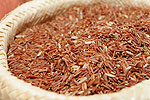 Red yeast rice is a part of Chinese cuisine (food coloring for Peking duck) as well as a medicinal agent. It is prepared by using a type of yeast, “Manascus purpureus,” fermented with rice, which was first recorded as being used during the Ming Dynasty (1368-1644). It also carries some excellent possibilities for lowering cholesterol.
Red yeast rice is a part of Chinese cuisine (food coloring for Peking duck) as well as a medicinal agent. It is prepared by using a type of yeast, “Manascus purpureus,” fermented with rice, which was first recorded as being used during the Ming Dynasty (1368-1644). It also carries some excellent possibilities for lowering cholesterol.
There are many chemicals in red yeast rice, including starch, sterols, isoflavones, monounsaturated fatty acids, and monacolins. Monacolin K is actually a statin; specifically, lovastatin, a commonly prescribed cholesterol-lowering drug. The amount of lovastatin varies with different fermentation processes, but may reach up to 0.8% per tablet. The Food and Drug Administration (FDA) considers red yeast rice products that contain statins to be illegal, unapproved drugs.
The following summarizes several high-quality clinical studies that show the effectiveness of red yeast rice in lowering cholesterol. It is based on one great meta-analysis that comprised 9,625 individuals in 93 different studies. “Cholestin,” “Xuezhikang” and “Zhibituo” are all red yeast rice supplements; the last two of Chinese origin. The meta-analysis’ key findings were:
— LDL Cholesterol: 22% reduction by Cholestin; 27% to 32% by Xuezhikang; and five percent by Zhibituo
— HDL Cholesterol: No change with Cholestin; a two-percent to 17% increase with Xuezhikang; a 15% to 22% increase with Zhibituo
— Total cholesterol: 16% reduction by Cholestin; 19% to 44% reduction by Xuezhikang; and 13% to 21% reduction by Zhibituo
— Triglycerides: Seven-percent reduction by Cholestin; 13% to 44% reduction by Xuezhikang; and 27% to 38% reduction by Zhibituo
The incidence of adverse effects ranged from 1.3% to 36%. The most common ones were gastrointestinal (loss of appetite, stomachache, nausea, distention, and diarrhea) and dizziness.
Overall, here is how red yeast rice supplements stack up against medication (statins) used to lower cholesterol.
— Statin Drugs: Lower LDL levels 18% to 55%…raise HDL levels five percent to 15%…lower triglycerides seven percent to 30%
— Red Yeast Rice: Lowers LDL levels five percent to 32%…raises HDL levels two percent to 22%…lowers triglycerides seven percent to 44%
NOTE: This article is one of many in a series I’ve been working on about effective natural ways to help improve your cholesterol levels. For the previous article, visit here.
